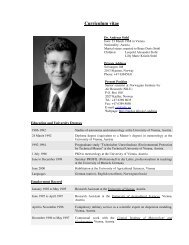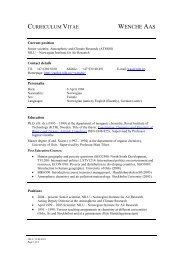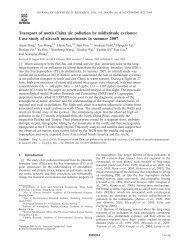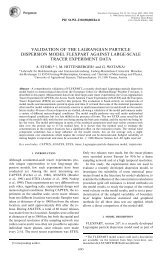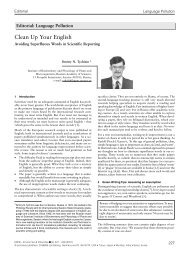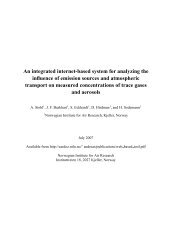Integration of measurements and model simulations to ... - NILU
Integration of measurements and model simulations to ... - NILU
Integration of measurements and model simulations to ... - NILU
Create successful ePaper yourself
Turn your PDF publications into a flip-book with our unique Google optimized e-Paper software.
10010 M. R. Perrone et al.: April 2010 Eyjafjallajökull volcanic aerosols over south-eastern Italy<br />
<strong>and</strong> back trajec<strong>to</strong>ry pathways reveal that the back trajec<strong>to</strong>ry<br />
ending on 20 April, 06:00 UTC at 100 m a.s.l. crossed the<br />
CNR IMAA Labora<strong>to</strong>ry area before reaching site G.<br />
3.5 Measurements <strong>and</strong> FLEXPART <strong>simulations</strong><br />
Experimental results are compared in this section with numerical<br />
results from the dispersion <strong>model</strong> FLEXPART <strong>to</strong><br />
contribute <strong>to</strong> the validation <strong>of</strong> the <strong>model</strong> abilities at a distance<br />
<strong>of</strong> approximately 4000 km from the volcano site. Dotted lines<br />
in Fig. 3 represent one-hour average vertical pr<strong>of</strong>iles <strong>of</strong> the<br />
volcanic ash mass concentration at the lidar site from FLEX-<br />
PART <strong>simulations</strong>. The comparison <strong>of</strong> solid <strong>and</strong> dotted lines<br />
in Fig. 3 reveals the ability <strong>of</strong> the <strong>model</strong> <strong>to</strong> catch, at least in<br />
some cases, main features <strong>of</strong> the aerosol vertical distribution<br />
retrieved from lidar <strong>measurements</strong>. One must be aware that<br />
volcanic ash mass concentration pr<strong>of</strong>iles from FLEXPART<br />
cannot be directly compared <strong>to</strong> lidar pr<strong>of</strong>iles, since FLEX-<br />
PART pr<strong>of</strong>iles are only representative <strong>of</strong> volcanic ash particles,<br />
while non-volcanic particles have also contributed <strong>to</strong> the<br />
retrieved lidar pr<strong>of</strong>iles.<br />
Notice that FLEXPART predicts the arrival <strong>of</strong> ash on 20<br />
April, 17:30 UTC (Fig. 3b, dotted line) within the altitude<br />
range for which backscatter coefficient values (Fig. 3b, solid<br />
line) were ascribed <strong>to</strong> a larger contribution <strong>of</strong> volcanic particles,<br />
in accordance with the discussion reported in Sect. 3.2.<br />
Aerosol particles up <strong>to</strong> about 4 km have been detected by<br />
the lidar at 23:30 UTC on 20 April <strong>and</strong> the vertical structure<br />
<strong>of</strong> β (Fig. 3c, solid line) <strong>and</strong> LR (Fig. 4b, full dots) have<br />
allowed inferring the presence <strong>of</strong> two aerosol layers, with<br />
the upper layer (2.1–3.3 km a.s.l.) characterized by larger LR<br />
values (64 ± 5 sr) due <strong>to</strong> a larger contribution <strong>of</strong> volcanic particles<br />
(Ansmann et al., 2010). Accordingly, the FLEXPART<br />
pr<strong>of</strong>ile at 23:30 UTC (Fig. 3c, dotted line) shows that a volcanic<br />
ash layer extends from ∼ 2 km up <strong>to</strong> 3.7 km a.s.l. The<br />
highest concentrations <strong>of</strong> about 170 µg m −3 at ∼ 3 km a.s.l.<br />
are about a fac<strong>to</strong>r <strong>of</strong> 7 lower than the highest values on 16<br />
April over Leipzig. This suggests that the volcanic ash over<br />
south-eastern Italy was strongly diluted. Notice that on 16<br />
April, Asmann et al. (2010) found from lidar <strong>measurements</strong><br />
at 355 nm performed over Leipzig, that backscatter <strong>and</strong> extinction<br />
coefficients reached peak values <strong>of</strong> 7.5 Mm −1 sr −1<br />
<strong>and</strong> 370 Mm −1 , respectively in the center <strong>of</strong> the ash plume.<br />
Figure 3c (solid line) <strong>and</strong> Fig. 4b (solid line) show that at<br />
23:30 UTC on 20 April backscatter <strong>and</strong> extinction coefficients<br />
reached values up <strong>to</strong> 0.7 Mm −1 sr −1 <strong>and</strong> 30 Mm −1 ,<br />
respectively, within 3–4 km a.s.l. We have assumed that the<br />
aerosol load located above 3 km from the ground was mainly<br />
due <strong>to</strong> volcanic aerosol. Hence, extinction <strong>and</strong> backscatter<br />
coefficients over Lecce in the volcanic aerosol layer were<br />
about a fac<strong>to</strong>r <strong>of</strong> 10 lower than the highest values moni<strong>to</strong>red<br />
at Leipzig on 16 April. This is in reasonable accordance<br />
with FLEXPART ratios <strong>of</strong> peak ash mass concentrations at<br />
Leipzig (16 April) <strong>and</strong> Lecce (20 April).<br />
Figure 3g (dotted line) shows that the simulated volcanic<br />
ash was mainly located from the ground up <strong>to</strong> ∼ 1.2 km<br />
<strong>and</strong> from 2 up <strong>to</strong> ∼ 3.7 km at 23:30 UTC on 21 April, in<br />
satisfac<strong>to</strong>ry accordance with lidar <strong>measurements</strong> which detected<br />
aerosol particles up <strong>to</strong> ∼ 3.7 km a.s.l. (Fig. 3g, solid<br />
line). Both the backscatter coefficient values (solid line) <strong>and</strong><br />
the simulated volcanic ash mass concentrations (dotted line)<br />
were characterized by rather low values at 17:30 UTC on 22<br />
April (Fig. 3l), suggesting an end <strong>of</strong> the volcanic ash episode.<br />
Figure 5 shows the time evolution from 20 <strong>to</strong> 22 April<br />
2010 <strong>of</strong> the ash <strong>to</strong>tal column mass concentration from FLEX-<br />
PART (Ma, full triangles) above the lidar site, in addition <strong>to</strong><br />
the aerosol optical thickness at 355 nm (open dots) retrieved<br />
from lidar <strong>measurements</strong>. Ash <strong>to</strong>tal column mass concentration<br />
values vary significantly with time <strong>and</strong> reach rather<br />
low values after midday on 22 April. Accordingly, we have<br />
found that AOT values also were quite dependent on moni<strong>to</strong>ring<br />
time <strong>and</strong> reached rather low values after midday on<br />
22 April. Ma <strong>and</strong> AOT reach high peak values at different<br />
times. Uncertainties in the <strong>model</strong> <strong>simulations</strong> which grow as<br />
the ash cloud is transported far from its source <strong>and</strong> over complex<br />
<strong>to</strong>pography (e.g., the Alps) (Kristiansen et al., 2012) are<br />
expected <strong>to</strong> lead <strong>to</strong> some discrepancies between the <strong>model</strong><br />
<strong>and</strong> <strong>measurements</strong> for the diluted ash cloud over Southern<br />
Italy. Kristiansen et al. (2012) found a time delay between the<br />
<strong>model</strong>led <strong>and</strong> measured PM 10 peak values at the Jungfraujoch<br />
station (Swiss Alps). However, one must be aware that<br />
changes <strong>of</strong> the contribution by volcanic <strong>and</strong> non-volcanic<br />
particles have contributed <strong>to</strong> the variability with time <strong>of</strong> the<br />
AOT, while Ma was only due <strong>to</strong> volcanic ash.<br />
The FLEXPART mass size distributions (dM/dLog(r)) for<br />
the moni<strong>to</strong>ring site <strong>of</strong> this study are plotted in Fig. 11a–<br />
c at different daytime hours <strong>of</strong> 20, 21, <strong>and</strong> 22 April. Mass<br />
size distribution pr<strong>of</strong>iles <strong>of</strong> Fig. 11 represent 1-hour-average<br />
pr<strong>of</strong>iles. Please note that the dM/dlog(r) data points <strong>of</strong> the<br />
20 April pr<strong>of</strong>ile at 23:30 UTC (Fig. 11a) must be multiplied<br />
by a fac<strong>to</strong>r <strong>of</strong> 2: volcanic ash mass concentrations reached<br />
the highest values on the night <strong>of</strong> 20 April over southeastern<br />
Italy. Figure 11 shows that <strong>model</strong>led mass size distributions<br />
are dominated by particles with radius r > 1 µm.<br />
Dotted <strong>and</strong> dashed lines in Fig. 8 show for comparison the<br />
FLEXPART mass size distributions referring <strong>to</strong> 11:30 <strong>and</strong><br />
14:30 UTC, respectively, on 21 April. Hence, experimentally<br />
determined dM A−B /dlog(r) values are in reasonable agreement<br />
with FLEXPART mass size distributions, within the<br />
<strong>model</strong> expected uncertainties: both the experimentally determined<br />
<strong>and</strong> the FLEXPART size distributions reveal the significant<br />
contribution <strong>of</strong> particles within the 0.6–4 µm radius<br />
range, even though peak values are reached at different radii.<br />
Again, one must be aware that FLEXPART particle size distributions<br />
cannot be directly compared <strong>to</strong> AERONET columnar<br />
volume size distributions, since non-volcanic particles as<br />
well as sulphate particles <strong>of</strong> volcanic origin may have contributed<br />
<strong>to</strong> the retrieved AERONET pr<strong>of</strong>iles. It is worth noting<br />
from Fig. 11 that the <strong>model</strong>ed mass size distributions for<br />
Atmos. Chem. Phys., 12, 10001–10013, 2012<br />
www.atmos-chem-phys.net/12/10001/2012/




